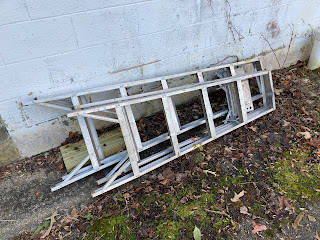This short post, as a tough year nears its end, may be a valuable one for anyone with an aluminum ladder.
The two examples pictured will soon go to the metal recycler, though they look fine. Why? They've been exposed too long to heat and cold, and for aluminum ladders, as we recently learned, that can mean failure. The shorter of the two began flexing dangerously where it folds.
I began to get paranoid after a 3' step ladder we'd kept outside in our hen yard broke, resulting in my wife getting a fracture. Careful inspection showed the front legs failed where a pin went through the metal, precisely where the ladder folds.
Now we are keeping all our ladders in buildings and not in the sun or exposed to freezing weather. Yet a cursory Google search reveals web sites that say storing metal ladders outdoors is fine, while others advise against it. No one in their right mind would store a wooden ladder outside, and I suppose fiberglass will degrade under UV light, too.
I took enough Physics and Chemistry classes to understand how metal expands with heat and contracts with cold. Over time, hairline cracks form in aluminum ladders, at joints of folding ladders in particular. I'm now going to inspect our folding ladders annually with a magnifying glass at each joint, and the extension ladders where the clamps lock or pivot.
You know those click-bait ads that talk about "Learn this one simple trick for..."? Well, here is one for ladders, DIYers. Get them out of the elements. I'd not leave extension ladders out, either.
Since Canada is infinitely more sensible than the US, advice from Canadian agencies on ladder inspection proved easy to find and far clearer than OSHA's legalese. Check here for Canadian basics when checking both extension and folding ladders. Werner Ladder has a YouTube video here.
Life is short enough as it is. No need to hasten the process. Get your ladders into a building.
Here's to a better 2022!





No comments:
Post a Comment